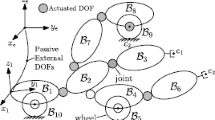Abstract
In this paper, a recursive formulation for generating the equations of motion of spatial mechanical systems is presented. The rigid bodies are replaced by a dynamically equivalent constrained system of particles which avoids introducing any rotational coordinates. For the open-chain system, the equations of motion are generated recursively along the serial chains using the concepts of linear and angular momenta. Closed-chain systems are transformed to open-chain systems by cutting suitable kinematic joints and introducing cut-joint constraints. The formulation is used to carry out the dynamic analysis of multi-link five-point suspension. The results of the simulation demonstrate the generality and simplicity of the proposed dynamic formulation.
Similar content being viewed by others
Abbreviations
- d i,j :
-
Distance between pointsi andj
- G 1 :
-
Vector sum of the moments of the external forces and force couples acting on the body with respect to particle 1
- Iξξ,Iηη,Iζζ:
-
Moments of inertia of the body with respect to the body attached coordinate frame
- Iξη,Iξζ,Iζη:
-
Products of inertia of the body with respect to the body attached coordinate frame
- m :
-
Mass of the body
- m i :
-
Mass of particlei
- m i,j :
-
Mass of the secondary particle that is located between the primary particlesi andj
- \(\bar r_G \) :
-
The position vector of the centre of mass of the body with respect to the body attached coordinate frame
- \(\bar r_i \) :
-
Position vector of particle i with respect to the body attached coordinate frame
- \(r_i ,\dot r,\ddot r_i \) :
-
Position, velocity, and acceleration vectors of particle i with respect to an inertial reference frame
- \(r_{i,j} ,\dot r_{i,j} ,\ddot r_{i,j} \) :
-
Relative position, velocity, and acceleration vectors between particlesi andj
- r Ti rj:
-
Algebraic notation denotes the dot product operation (ri,r)
- \(\tilde r_i r_j \) :
-
Algebraic notation denotes the cross product operation (rixrj)
- R:
-
Vector sum of the external forces acting on the rigid body
- ξi, ηi, ζi:
-
Coordinates of particle i with respect to the body attached coordinate frame
References
Attia, H. A., 1993, A Computer-Oriented Dynamical Formulation with Applications to Multi-body Systems, Ph.D. Dissertation, Department of Engineering Mathematics and Physics, Faculty of Engineering, Cairo University.
Attia, H. A., 1998, “Formulation of the Equations of Motion for the RRRR Robot Manipulator, ” Transactions of the Canadian Society for Mechanical Engineers, Vol. 22, No. 1, pp. 83–93.
Denavit, J., Hartenberg, R. S., 1955, “A Kinematic Notation for Lower-Pair Mechanisms Based on Matrices,” ASME Journal of Applied Mechanics, pp. 215–221.
De Jalon, J. G. and Bayo, E., 1994, “Kinematic and Dynamic Simulation of Multibody Systems,” Springer.
Goldstein, H., 1950, Classical mechanics, Addison-Wesley, Reading, Mass.
Kim, S. S. and Vanderploeg, M. J., 1986, “A General and Efficient Method for Dynamic Analysis of Mechanical Systems Using Velocity Transformation,” ASME Journal of Mechanisms, Transmissions and Automation in Design, Vol. 108, No. 2, pp. 176–182.
Nikravesh, P. E., 1988, Computer Aided Analysis of Mechanical Systems, Prentice-Hall, Englewood Cliffs, N.J.,
Nikravesh, P. E. and Gim, G., 1989, “Systematic Construction of the Equations of Motion for Multibody Systems Containing Closed Kinematic Loop,” ASME Design Conference.
Nikravesh, P. E. and Affifi, H. A., 1994, “Construction of the Equations of Motion for Multibody Dynamics Using Point and Joint Coordinates, ” Computer-Aided Analysis of Rigid and Flexible Mechanical Systems, Kluwer Academic Publications. NATO ASI, Series E: Applied Sciences-Vol. 268, pp. 31–60.
Orlandea, N., Chace, M. A. and Calahan, D. A., 1977, “A Sparsity-Oriented Approach to Dynamic Analysis and Design of Mechanical Systems, Part I and II,” ASME Journal of Engineering for Industry, Vol. 99, pp. 773–784.
Sheth, P. N. and Uicker, Jr. J. J., 1972, “IMP (Integrated Mechanisms Program), A Computer-Aided Design Analysis System for Mechanisms Linkages,” ASME Journal of Engineering for Industry, Vol. 94. p. 454.
Author information
Authors and Affiliations
Corresponding author
Rights and permissions
About this article
Cite this article
Attia, H.A. A recursive algorithm for generating the equations of motion of spatial mechanical systems with application to the five-point suspension. KSME International Journal 18, 550–559 (2004). https://doi.org/10.1007/BF02983639
Received:
Revised:
Published:
Issue Date:
DOI: https://doi.org/10.1007/BF02983639




